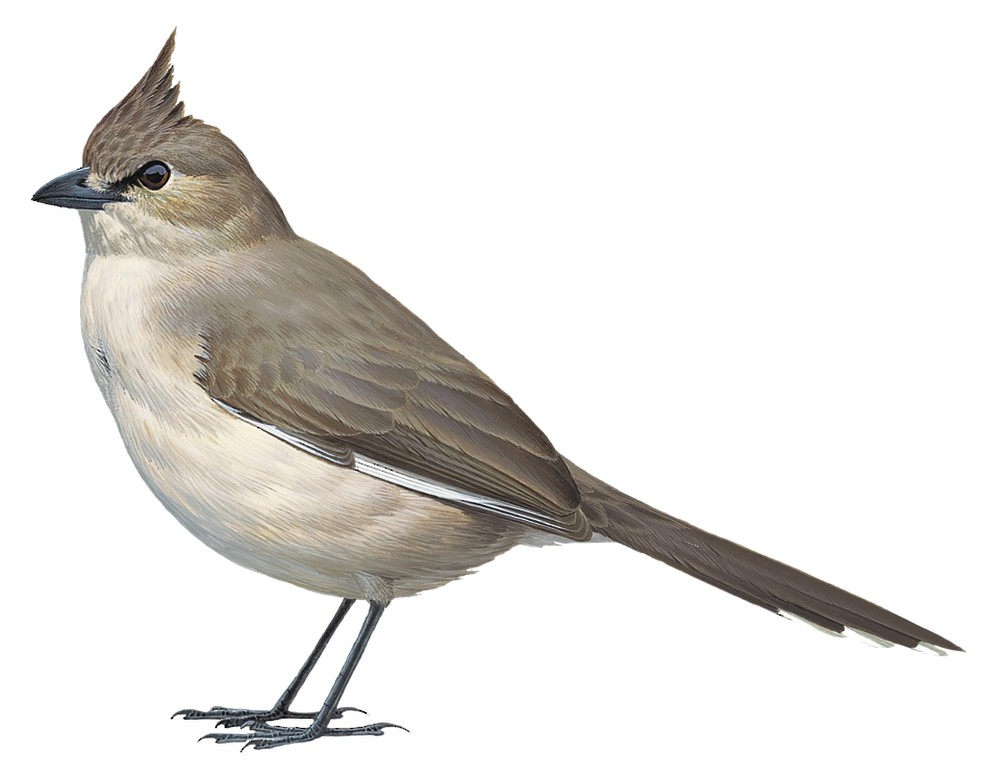Chirruping Wedgebill / Psophodes cristatus

Chirruping Wedgebill
SCI Name:
Protonym: Sphenostoma cristatum Syn.BirdsAustr. pt4 pl.[8]
Taxonomy: Passeriformes / Psophodidae / Psophodes
Taxonomy Code: chiwed2
Type Locality: New South Wales.
Author: Gould
Publish Year: 1838
IUCN Status: Least Concern
DEFINITIONS
PSOPHODES
(Psophodidae; Ϯ Eastern Whipbird P. olivaceus) Gr. ψοφωδης psophōdēs noisy, full of sound < ψοφος psophos noise; "Genus. PSOPHODES*. Rostrum forte, breve, subrectum, subcompressum; culmine vix carinato, subarcuato; mandibulis integris; naribus basalibus, ovalibus, plumulis setisque frontis opertis; rictu vibrissis fortibus incumbentibus instructo. Alæ brevissimæ, rotundatæ; remigibus prima brevi, secunda tertia et quarta gradatim longioribus, quinta ad nonam inclusam fere æqualibus, longissimis. Cauda elongata, gradata. Pedes subfortes, subelongati; acrotarsiis scutellatis, paratarsiis integris. This form offers one of the greatest difficulties to the investigator of affinities. The birds that exhibit it are said to be Honey-Eaters. This we much doubt. They are found among the flowers of the Eucalypti; but this circumstance may arise as well from their being in search of the insects abounding in these flowers, as of the honey contained in them. It is strange that we have never been able to examine a tongue of these birds, although the skins are common. Their general appearance indicates much of the Shrike. The strong bristles of the rictus suggest the idea of their food being animal, and indeed originally induced Dr. Latham to place them in the Linnean Muscicapæ. The integrity of the margins of the bill, on the other hand, seems to militate against this supposition. The extreme shortness and roundness of the wing again, and the long and graduated tail, are additional characters that demand consideration. ... *ψοφος crepitus. ... 1. CREPITANS. ... Muscicapa crepitans. Lath. Ind. Orn. Supp. p. li. no. 10. Coach-whip Honey-Eater. Id. Gen. Hist. iv. p. 187. no. 43. Mr. Caley informs us that "this bird is more often heard than seen. It inhabits brushes. The loud cracking whip-like noise it makes (from whence the colonists give it the name of Coach-whip) may be heard from a great distance."" (Vigors & Horsfield 1827); "Psophodes Vigors and Horsfield, 1827, Trans. Linn. Soc. London, 15, p. 328. Type, by monotypy, Muscicapa crepitans Latham = Corvus olivaceus Latham." (Deignan in Peters 1964, X, 229).
Var. Psofodes, Phosphodes.
Synon. Phodopses, Sphenostoma.
cristatum / cristatus
L. cristatus crested, plumed, tufted < crista crest, plume, tuft.
● ex “Quauhtzonecolin” of Hernandez 1651, “Coturnix indica” of Ray 1713, and “Caille hupée du Méxique” of Brisson 1760 (Colinus).
● ex “Figuier huppé de Cayenne” of d’Aubenton 1765-1781, pl. 391, fig. 1, and de Buffon 1770-1783, and “Crested Warbler” of Latham 1783 (syn. Colopteryx galeatus).
● ex “Moineau de Cayenne” of d’Aubenton 1765-1781, pl. 224, fig. 3, “Friquet huppé” of de Buffon 1770-1783, and “Black-faced Finch” of Latham 1783 (syn. Coryphospingus cucullatus).
● ex “Drongo” of Levaillant 1805, pl. 166 (syn. Dicrurus forficatus).
● "43. LANIUS. ... cristatus. 1. L. cauda cuneiformi, capite cristato, corpore rufescente, subtus fulvo fuscoque undulato. Lanius fulvus cristatus. Edw. av. 54. t. 54. Habitat in Benghala." (Linnaeus 1758). Edwards' 1747, “Crested Red or Russit Butcher-Bird,” is from a drawing of a dishevelled dead bird shown with a crest (Lanius).
● "100. PARUS. ... cristatus. 1. P. capite cristato. Fn. svec. 239. Parus cristatus. Gesn. av. 642. f. med. Aldr. orn. l. 17. c. 20. Will. orn. 175. t. 43. Raj. av. 74. n. 6. Alb. av. 2. p. 53. t. 57. f. 2. Frisch. av. . . t. 14. f. 2. Habitat in Europa." (Linnaeus 1758) (Lophophanes).
● ex "Tangara noir hupé de Cayenne" of Brisson 1760 (Loriotus).
● ex “Hoactzin” of Willughby 1676, and Ray 1713, “Crax fuscus mexicanus” of Brisson 1760, “Faisan huppé de Cayenne” of d’Aubenton 1765-1781, pl. 337, “Hoazin” of de Buffon 1770-1782, and “Crested Pheasant” of Latham 1783 (syn. Opisthocomus hoazin).
● "60. TROCHILUS. ... cristatus. 17. T. rectirostris viridis, alis fuscis, abdomine cinereo, crista cærulescente. Mellivora minor cristata. Edw. av. 37. t. 37. Habitat in America." (Linnaeus 1758) (Orthorhyncus).
● ex “Merula Sinensis cristata minor” of Brisson 1760 (syn. Otocompsa jocosa).
● "87. PAVO. ... cristatus. 1. P. capite crista erecta. Pavo cauda longa. Fn. svec. 163. Pavo. Gesn. av. 656. Aldr. orn. l. 13. c. 1. Jonst. av. 56. t. 22. Will. orn. 112. t. 27. Raj. av. 51. Habitat in India orientali, Zeylona. Mas remigibus primoribus ferrugineis, ejulans, vindicans, superbus, togam dorsalem gemmantibus ocellis, naturæ miraculo pictam erigendamque, tertio anno acquirit, qua nihil pulchrius, sub canicula dejicit. Femina curat pullos in proximas nuptias. Sambucci floribus occiditur." (Linnaeus 1758) (Pavo).
● "68. COLYMBUS. ... cristatus. 2. C. pedibus lobato-fissis, capite rufo, collari nigro, remigibus secundariis albis. Fn. svec. 122. Colymbus major cristatus s. cornutus. Gesn. av. 139. Aldr. ornith. l. 19. c. 52. Will. orn. 257. t. 61. Raj. av. 124. Marsil. danub. 80. t. 38. Habitat in Europa." (Linnaeus 1758) (Podiceps).
● ex “Cassicus cristatus” of Brisson 1760, “Cassique huppé de Cayenne” of d’Aubenton 1765-1781, pl. 344, and “Crested Oriole” of Latham 1782 (syn. Psarocolius decumanus).
● ex "Pluvier armé du Sénégal" of d'Aubenton 1765-1781, pl. 800 (syn. Vanellus senegallus).
● "79. CHARADRIUS. ... cristatus. 1. C. gula pileo pectoreque nigris, occipite cristato, dorso testaceo, pedibus nigris. Pluvialis indicus, pectore nigro. Edw. av. 47. t. 47. Habitat in Persia. Simillimus est Tringæ Vanello." (Linnaeus 1758) (syn. Vanellus spinosus).
● ex “Vultur leporarius” of Gessner 1555, and Ray 1713, “Vultur cristatus” of Brisson 1760, “Vautour à aigrettes” of de Buffon 1770-1783, and “Hare Vulture” of Latham 1781 (unident.).
● see cristata
UPPERCASE: current genus
Uppercase first letter: generic synonym
● and ● See: generic homonyms
lowercase: species and subspecies
●: early names, variants, mispellings
‡: extinct
†: type species
Gr.: ancient Greek
L.: Latin
<: derived from
syn: synonym of
/: separates historical and modern geographic names
ex: based on
TL: type locality
OD: original diagnosis (genus) or original description (species)












